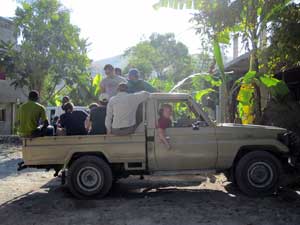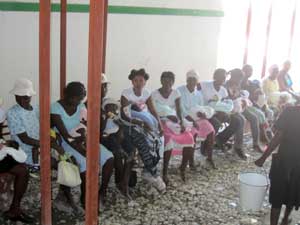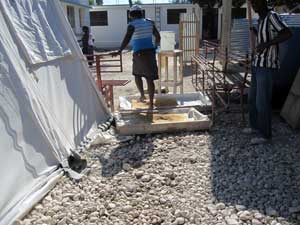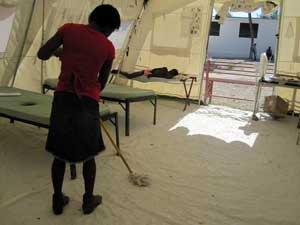
 |
| Heading for the hills |
Today most of the people in the Medical Student Missions group piled into a 4WD truck and went to the mountains with the Cuban doctors to check on cholera patients. (I didn't see any American doctors in Haiti.)
I was told that Cuba sends female doctors because women care about their families and won't defect to the USA. Lame guys?
 |
| Babies Galore |
Haiti has tremendous challenges: no tourism, few exports, and few jobs. This is compounded by an apparent baby-factory mentality. Making babies is something they're good at. More people aren't what the island needs.
I'd planned on administering infant immunizations this morning, but the nurses didn't want the Blanc's help. They'd probably heard about my 16-penny nails.
Feeling unwanted, I went to the lab to help draw blood. I found a vein in my first patient, but couldn't extract much blood. Fellow American Eric (a medical assistant from Illinois) restuck the poor guy and eeked out 2 mL of the 4 we needed. On the next patient, I couldn't get a drop; nor could Eric. The nurse tried and didn't get any, so she had the patient hold a vial next to his arm to catch drips of the (now contaminated) blood into the test-tube-like container. I couldn't find a vein to stick on my third patient, nor could Eric, so the nurse dug crazily with the needle and managed to suck out 1 mL of capillary blood from his muscle. Ugly.
 |
| Bleach-soaked doormat |
 |
| Hole in cots |
The first time I walked into the cholera clinic (a tent), I stepped over the strange wooden boxes filled with soggy foam rubber—I didn't want to get my shoes dirty. I quickly discovered that the bleach-soaked foam was there to clean our shoes of the cholera critters. It makes sense once you see a cholera patient unloading all of their body fluids rectally.
Pails are placed below the holes in the cots to catch the patients' excrement. The floor is continuously mopped with bleach.
As I'm touring the cholera clinic, an ambulance pulls up with a boy, probably 7 or 8 years old. I'm told the ambulance is coming from his home in the mountains which is several hours away. His parents pull up his pants and help him out of the ambulance. As they are helping him stand, his eyes roll back in his head and he faints. Eric and the boy's father rushed him directly to the pediatric tent. Eric starts an IV and the nurse pushes the needle to the hilt, slides in the catheter, and blows out the vein. So she tries to hydrate the boy orally only to have him vomit on the floor. Keep mopping.
I was hanging around with my translator, Alexandre Herold, talking about life, languages, and Haiti, when one of the Haitian nurses came in and said something to Alexandre in French. All I could make out from the conversation was, “Blanc" (a.k.a. "whitey").
Alexandre explained that she wanted me to look at a burn patient from yesterday. I walked into a 20′ x 20′ open room that's the hospital “lodging" and saw a 20-something-year-old woman, behind mosquito netting, with partial and full-thickness burns on her bare chest. Our folks had helped debride the wound yesterday and Eric had applied Second Skin (a jelly-like sterile burn dressing). The woman was moaning and screaming, saying (in Creole) that her chest was burning and begging me to take off the dressing.
Trying to mask my not knowing what to do, I proceeded to check her vitals (always a good time killer while seeking composure). Her pulse was a screaming 120 beats per minute and very weak, her respirations rapid, and her hands were cold with pale fingernail beds. These were obvious signs of serious (septic) shock. Not good. She was slipping away in front of me.
There isn't really any hospital staff here—just folks providing random medical care in various rooms. I had Alexandre find one of the Cuban docs and in my halting Spanglish, I explained that I had a patient with a “rápido" pulse (as I mimed taking my pulse), “rápido" breathing (as I made my chest rise and fall rapidly), “blanco" nailbeds (pointing to my own), and “frío" hands. My acting must have worked, because she replied, “Shock?" to which I nodded vigorously and replied, “Si, hypovolémic." (It's a good thing most medical terms are in Latin—our common language.)
The doc followed me to the patient, felt her head, and said “Inferno." She checked the mucus membranes around the women's eyes (they were pale), and agreed, saying something like “Si, septic, por un infección." I wanted to start an IV, but I don't think there was any fluid in the hospital. The doc said, “No IV. Necesita una transfusión. No hemoglobina." I'm not so sure it was a hemoglobin issue, but I'm glad the doc saw it as seriously as I did. She filled out some paperwork that would allow the woman to be admitted to the neighboring hospital. Her family loaded her up, and away she went, still screaming.